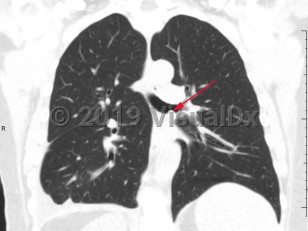Bronchial carcinoid tumors are malignant neuroendocrine neoplasms. They derive from the enterochromaffin cells of the bronchial mucosa and can secrete serotonin, adrenocorticotropic hormone (ACTH), and other neurohormones. Generally, carcinoid tumors are most commonly found in the small bowel, but they can also arise in the colon, appendix, rectum, and proximal airways. While bronchial carcinoid tumors make up around a quarter of all neuroendocrine tumors, they account for around 1% of all
lung cancers. Sporadic carcinoid tumors that are well-differentiated have been associated with a loss of heterozygosity at the
MEN1 gene (see
multiple endocrine neoplasia type 1).
These tumors are graded on histological appearance:
- Grade 1 describes well-differentiated tumors with a zellballen or nesting appearance.
- Grade 2 describes cells with atypical appearance or increased mitotic activity in otherwise well-differentiated cells.
- Grade 3 describes poorly differentiated cells.
Most carcinoid tumors are well-differentiated and associated with a 5-year survival rate of more than 80%. Well-differentiated tumors are also less likely to metastasize than the atypical or poorly differentiated variations.
Bronchial carcinoid tumors occur in adulthood with an approximate average age of diagnosis in the early to mid-50s. Common findings include cough, dyspnea, chest pain, hemoptysis, wheezing (as a result of either airway obstruction or, less often,
carcinoid syndrome), and reoccurring pneumonia. ACTH-secreting tumors may result in
Cushing syndrome. Excess serotonin secretion may cause carcinoid syndrome; however, carcinoid syndrome is more commonly a manifestation of gastrointestinal carcinoid tumors and may be a sign of metastasis with a primary bronchial carcinoid tumor.



